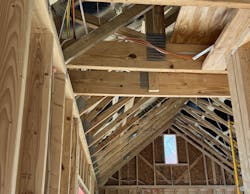Proper attic airflow is an important aspect to comfortable, healthy indoor living, but also to a roof’s structural integrity. Roof ventilation allows for the escape of hot air, minimizing moisture that can damage a roof’s strength and create mold.
But like many other construction changes resulting from building science research, there remains a divide on the necessity of more complicated, product-heavy assemblies. Where lab results and data show a “correct” way to construct or remodel a home, arguments from the jobsite over cost, attainability, climate zone, and general necessity arise.
The discussion of whether or not to vent a roof recently popped up in a recent update of Pro Remodeler’s Model ReModel 2022 project.
The Model ReModel contractors, Nicole Tysvaer and Matt Kulp of Symbi Homes, debated two options for their vaulted ceiling: R-48 open cell spray foam at underside of roof with no soffit or ridge venting, or dense-packed cellulose with a vented soffit, baffles, and open ridge vent.
The conversation sparked great reader interest, and the reply of a well known building science expert, Michael Anschel of OA Design + Build + Architecture in Minneapolis.
While Anschel stands firm on studies and data determining the best roof assemblies, Symbi Homes argues that “best” may be difficult on affordability. In an attempt to strike a middle ground between high-performance and attainable, the three remodelers engaged in a candid conversation.
What does science say?
Anschel: There are techniques and systems that we hold on to that we continue to find ways to make them work, but we also have really clear, good data from organizations like Berkeley Lab or Oak Ridge Lab that shows us what the best assemblies are and how to manage the assemblies best.
I joke that we spend hours debating fan size or cubic foot ventilation size requirements for dwelling units. We are arguing in the hundreds of decimal points while we're building to the quarter to the eighth of an inch. And there's some significant disparity between the practices of building in the field and what happens in the labs. What might seem like a discussion at the lab level isn't meant to be a discussion at the field level.
If you're doing vaulted roofs, the best assembly is always going to be insulation on the exterior of the roof deck. If you're doing a vaulted roof and in a mixed climate, you definitely need to stay away from vapor open assemblies.
Roof assemblies where you have framing, roof deck, and then you have layers of polyiso, and then you have your membrane—that's going to be your best performer. Then we move into residential assemblies where we don't necessarily want to do 50 boards, and so we look for compromises.
Those compromises can be in the form of a 50/50 split where you bring 50% of that insulation to the top side of the roof deck and the other 50% up to the underside of the roof deck in the form of closed cell spray foam, so that they function as a single air sealed assembly. You don't have any air pathways through it.
The next solution would be the entirety of the installation is inside the framing cavity. Again, closed cell spray foam in a vaulted assembly so that you're airtight to the roof deck.
And if you're going to put venting in place, you're going to put the venting on the top side of the roof deck the same as we would in a wall assembly. For ventilated rainscreen, it’s the same thing.
Once you've got your weatherproofing down, then you're going to add furring strips or use one of the mat type systems to nail down over so that if there's airflow taking place, it's taking place between the shingle and the web. Not anywhere else in the assembly.
The old school method of bringing air into a building as a method of managing moisture that might build up at the underside of the roof decking is kind of antiquated.
The challenge is if you don't want to use closed cell spray foams, right? Then you get into this question of, “Well, what are my alternative materials?”
And the problems with unvented attic assemblies with batt fiberglass is that they don't work very well. You end up having to cut venting cavities, which doesn't work for net zero or air tightness.
Low-density, low-medium density spray foams can be used in those assemblies, but require a vapor retarder that sprays over the surface over the foams to make them vapor impermeable.
But what about cost? And a products’ effect on the environment?
Symbi: Budget is a major factor. The perfect assemblies you talk about are very expensive. What I’m curious about is other assemblies that are more cost-effective for somebody with a budget? We want to remodel houses in neighborhoods that aren’t affluent and try to bring sustainability and lower people’s utility bills. Maybe the conversation is when to vent or when not to?
Read the full conversation at the project site of Model ReModel 2022.
